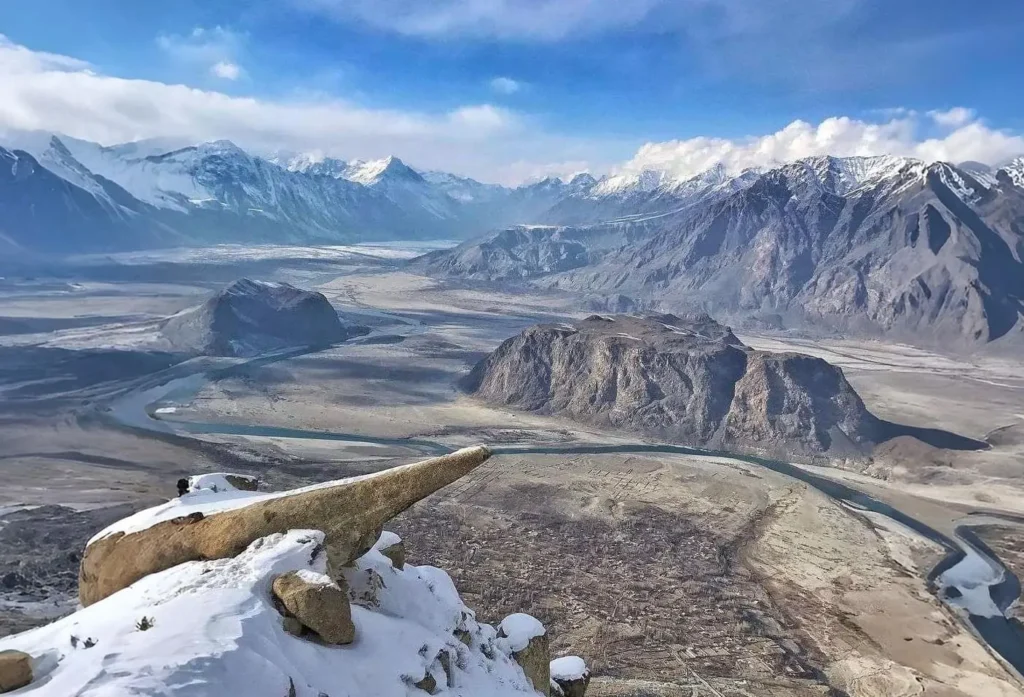
Imagine standing at the edge of the world, on a narrow granite ledge soaring above the Skardu valley, wind in your face, and silence echoing through the Karakoram mountains. That’s Marsur Rock – Gilgit-Baltistan’s hidden gem, often called Pakistan’s Trolltunga.
Discovered by local photographers in 2017 and rising to popularity in 2018, this rock formation is a visual marvel and a short trekker’s dream—ideal for nature lovers, adventurers, and photographers seeking a unique view of northern Pakistan. If you’re visiting Skardu, Marsur Rock should be at the top of your itinerary.
📍 What is Marsur Rock?
Marsur Rock, or the Hussainabad Slab, is a 38-foot natural ledge perched 25 feet high at 3,737m, offering stunning views of Skardu and the Indus River. Its shape and protrusion resemble Norway’s Trolltunga—but here, you’ll find fewer tourists and deeper silence.
The rock is partially embedded into the mountain (~13 feet), creating a knife-edge profile that offers panoramic views of Skardu City, the Indus River, and the Safaranga Cold Desert. It’s often referred to as the Marsur Rock of Pakistan for its unique geological and visual appeal.
This spectacular location has also attracted the attention of archaeologists due to nearby ancient Buddhist carvings, making Marsur Rock not just a trekker’s paradise but also a place of historical significance.
🗺️ Location and How to Reach Marsur Rock
Region: Hussainabad, near Skardu, Gilgit-Baltistan
Starting Elevation: ~3,026 meters
Summit Elevation: ~3,737 meters
Total Trail Length: ~5.7 km round trip
Estimated Time: 2–3 hours hike, 10–15 minutes jeep ride from Skardu
Trail Difficulty: Moderate (for hikers with basic fitness)
🚗 Start from: Skardu or Shigar → Take a jeep to the edge of Hussainabad village (~10 mins)
🚶♂️ Trail begins at: A small bridge with a mountain stream (local water source)
📌 Insert Image Alt Text: “Marsur Rock trail from Skardu through Hussainabad”
🥾 Marsur Rock Trek Route: Step-by-Step Guide
1. Bridge & Grassy Start
Begin your Marsur Rock trek by crossing the metal bridge. Hike beside the freshwater stream through green meadows. The lush pastureland sets the tone for what’s ahead.
2. The Fork – Choose Wisely
After 60 minutes, you’ll reach a fork.
➡️ Skip the gentler first trail
➡️ Take the steeper path upward, which leads directly to Marsur Rock
3. Rocky Ascent
The terrain turns alpine and rocky.
🛖 Rest in the wooden huts scattered along the way.
🪨 Look for the “Love Rock” (a heart-shaped boulder) 150m before reaching Marsur Rock.
4. Final Stretch
Near the top, take a left turn at the saddle, followed by a brief descent. The path gently slopes down to the Marsur Rock ledge — your panoramic reward awaits.
🌄 Why Visit Marsur Rock?
🔭 Unmatched Panoramic Views
From Marsur Rock, you can see:
Skardu city beneath your feet
The winding Indus River
The golden plains of the Safaranga Cold Desert
Majestic Karakoram peaks
Ancient ruins near the summit
📌 Insert Image Alt Text: “View from the top of Marsur Rock showing Skardu valley”
🧘♂️ Peaceful & Raw Nature
Unlike tourist-heavy spots, Marsur Rock is untouched — no crowds, no shops, no barriers. It’s just you, nature, and 360° silence.
🏛️ Cultural & Geological Fusion
Marsur Rock is not just stone—it’s story. Nearby Buddhist-era engravings and the rock’s dramatic granite structure make it a rare blend of geology and archaeology.
🧳 What to Pack for the Marsur Rock Trek
| Item | Why You Need It |
|---|---|
| Hiking shoes | Rocky and uneven trail |
| Trekking poles | For balance and support |
| 2L water per person | No refill points after the spring |
| Snacks & energy bars | Keep energy up during the 2–3 hr climb |
| Light jacket/fleece | Cold winds hit hard at the summit |
| Sunglasses + Hat | Sunlight is intense at high altitude |
| Sunscreen | Essential UV protection |
| Offline maps | No mobile signal on the Marsur Rock trail |
📌 Insert Image Alt Text: “Marsur Rock hiking essentials checklist”
📅 Best Time to Visit Marsur Rock
Best Season: August to October (clear skies, dry trail)
Avoid: Winter & Monsoon (snow and rain make the rock slippery)
Golden Hour: Sunrise and sunset views from Marsur Rock are magical
⚠️ Marsur Rock Safety & Trekking Tips
Zero Mobile Coverage: Tell someone your plan before departure
Slippery When Wet: Don’t hike after rain
Altitude Consideration: At 3,700m+, stay hydrated and climb slowly
No Guide Needed: But local guides enhance safety and experience
Pack Out Trash: Preserve the Marsur Rock trail’s natural beauty
🔗 Suggested Nearby Attractions (Internal Linking for SEO)
Kharpocho Fort – Skardu’s historical fortress
Shangrila Lake – The famous heart-shaped lake
Katpana Lake – Nearby cold desert lake
Deosai Plains – The second-highest plateau on Earth
Upper Kachura Lake – A pristine alpine lake 30 minutes from Skardu
🙋 Frequently Asked Questions (FAQ)
What is Marsur Rock famous for?
Marsur Rock is famous for its dramatic shape, resembling Norway’s Trolltunga, and for its panoramic views over Skardu. It’s also known for its quiet, natural setting and proximity to Buddhist relics.
Is the Marsur Rock trek difficult?
It’s moderately challenging. Most hikers with basic fitness can complete it in 4–6 hours (round trip) including rest.
How far is Marsur Rock from Skardu?
It’s roughly a 10-minute jeep ride and 2–3 hours hike from Skardu city.
Can I go alone?
Yes, many go unguided. However, if unfamiliar with the terrain, a local guide is recommended for first-time hikers.
Is there any mobile signal?
No. The Marsur Rock trail has zero connectivity, so download offline maps and inform someone of your plan.
✍️ Final Thoughts on Marsur Rock
Marsur Rock is not just a trekking destination — it’s a full-spectrum experience that blends nature, history, and adventure. With just a day’s journey from Skardu, you can stand on one of Pakistan’s most scenic ledges, capture breathtaking photos, and feel the vastness of the Karakoram landscape.
Whether you’re a photographer, trekker, or cultural explorer, Marsur Rock delivers a view — and feeling — that will stay with you long after the hike ends.
📸 Been to Marsur Rock? Share your experiences, tag us in your posts, or drop a comment below.
🌐 Subscribe for more hidden northern Pakistan travel gems.
